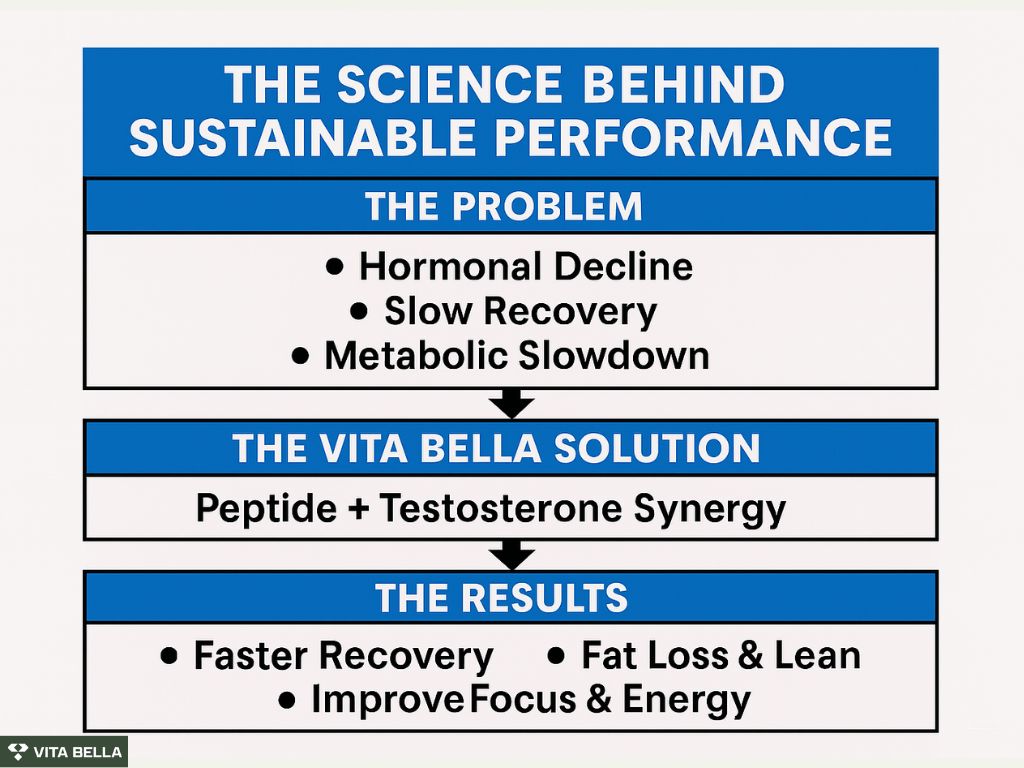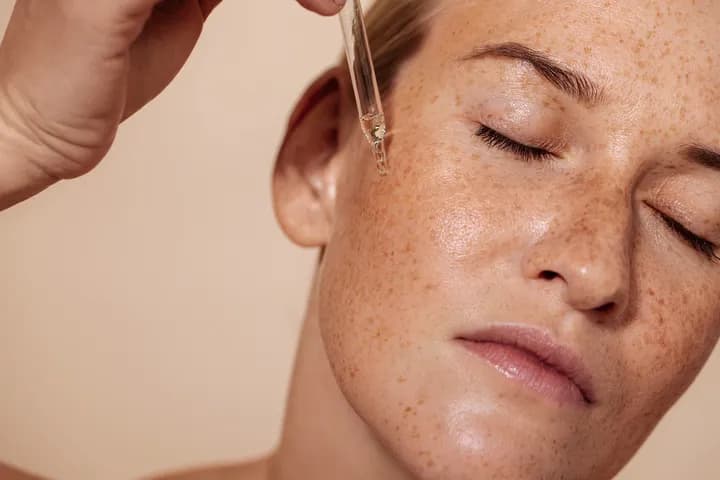When energy fades, focus drifts, and recovery slows, your body isn’t breaking down; it’s asking for balance. Testosterone therapy (TRT) has long been a cornerstone of male vitality and physical optimization. But when combined with peptide therapy, this approach can unlock synergistic benefits, enhancing muscle recovery, hormone balance, and overall performance. Together, they form what many experts call the ultimate performance stack.
Step into a new era of performance and longevity with Vita Bella’s clinically formulated peptide and testosterone therapies. Each solution is backed by human research and designed to optimize energy, strength, and recovery at the cellular level. Whether your goal is sharper focus, lean muscle, or balanced energy, Vita Bella delivers measurable results with medical precision.
Why Combine Peptides with Testosterone Therapy?
Testosterone therapy (TRT) 1 restores energy, muscle density, and libido, but it may suppress the body’s own luteinizing hormone (LH) and follicle-stimulating hormone (FSH) production. Peptide Therapy supports those natural signals while promoting muscle recovery and balanced hormone function.
According to research 2, peptides further enhance testosterone’s anabolic benefits by elevating growth hormone (GH) and insulin-like growth factor-1 (IGF-1), two cornerstones of tissue repair and metabolic balance. The combination improves endurance, accelerates recovery, and stabilizes energy without overstressing the endocrine system.
What Peptides Complement Testosterone Therapy?
Peptides such as CJC-1295 and Ipamorelin can enhance growth hormone release, supporting muscle gain, fat loss, and recovery alongside testosterone therapy. Additionally, BPC-157 and TB-500 may complement testosterone by promoting tissue repair, reducing inflammation, and improving overall physical performance.
1. GLP-1 Receptor Agonist (Semaglutide)
GLP-1 Receptor Agonist utilizes semaglutide, a peptide clinically proven to improve metabolic efficiency. In a 68-week human trial 3, semaglutide reduced body weight by ~15% while enhancing insulin sensitivity and cardiovascular health. When paired with testosterone therapy, it helps preserve lean muscle, stabilize blood sugar, and improve stamina.
2. Tesamorelin
Tesamorelin is a targeted growth hormone-releasing peptide designed to raise GH and IGF-1 naturally. In human phase III studies 2, tesamorelin increased IGF-1 by >180 µg/L on average and cut visceral fat by 15–20%. Combined with TRT, it supports tissue repair, deeper sleep, and sharper cognition, hallmarks of sustainable performance.
3. HCG Support
The review 4 "Indications for the Use of Human Chorionic Gonadotropin (hCG)" notes that low-dose hCG co-administered with testosterone replacement therapy maintains intratesticular testosterone and preserves spermatogenesis over one year.
A more recent article 5 on restoring spermatogenesis after testosterone therapy also discusses how gonadotropic stimulation (e.g. with hCG) can rescue testicular function suppressed by exogenous testosterone.
4. CJC-1295 + Ipamorelin Blend
The CJC-1295 + Ipamorelin Blend stimulates natural GH release and IGF-1 elevation, improving collagen formation, fat metabolism, and recovery. Human research 1 shows GH secretagogues can raise IGF-1 by 30–35%, leading to stronger tissue regeneration and leaner body composition.
What are the Benefits of the Peptide + Testosterone combination
Combining peptides with testosterone enhances muscle growth, recovery, and metabolic health while maintaining hormonal balance. This synergy boosts strength, energy, and overall energy for sustainable performance and longevity. When combined thoughtfully, this stack can deliver:
Stronger anabolic response: TRT enhances muscle protein synthesis, while peptides like GH secretagogues and upstream stimulators further accelerate growth and recovery.
Improved hormonal flexibility: Unlike high-dose TRT alone, peptides allow modulation of LH/FSH, preserving fertility and endogenous hormonal signaling.
Enhanced metabolism & fat loss: GH-stimulating peptides improve insulin sensitivity and lipolysis, enhancing TRT’s effects on body composition.
Better tissue repair & recovery: Elevated GH, IGF-1, and testosterone synergize to speed healing, reduce catabolism, and maintain performance.
Reduced side effects & suppression: Because peptides act upstream, they may permit lower TRT doses and mitigate side effects like testicular atrophy or axis suppression.
What are the Safety & Practical Considerations of Peptides and Testosterone Therapy?
Peptides and testosterone therapy are safe and well-tolerated when administered under medical supervision. Regular hormone monitoring, proper dosing, and pharmaceutical-grade formulations ensure optimal results while minimizing risks. Combining peptides and TRT demands medical oversight. Key considerations:
Use cycling or pulsatile peptides to avoid receptor desensitization (e.g. continuous kisspeptin may blunt effect).
Monitor LH, FSH, testosterone, IGF-1, hematocrit, and liver function frequently.
Start peptides at lower doses and adjust slowly based on response.
Ensure injectables or peptides are pharmaceutical grade and prescribed.
Avoid stacking excessively high anabolic regimens to reduce cardiovascular, metabolic, or endocrine risks.

What is the Scientific Support for the Stack of Peptides and Testosterone Therapy?
Human studies 2 consistently show that integrating peptides with TRT improves overall health outcomes. Semaglutide enhances insulin control and cardiovascular resilience, while tesamorelin and GH secretagogues boost muscle density and recovery rates. HCG preserves fertility and hormonal equilibrium, creating a scientifically grounded performance model.
What is the Safety and Clinical Precision of Peptides and Testosterone Therapy?
All Peptide and Testosterone Therapies are physician-directed and produced to pharmaceutical standards. Human trials 6 of semaglutide and tesamorelin confirm predictable dosing, favorable safety, and minimal side effects. Routine monitoring of testosterone, IGF-1, and metabolic markers ensures optimal results.
Get Back on Track - Restore Your Recovery with Vita Bella
If you’re noticing longer recovery times, disrupted sleep, or declining energy, your cellular engine is asking for support.
Vita Bella’s peptide and testosterone protocols reignite your natural hormone rhythm, accelerate repair, and enhance endurance. Get back to feeling powerful, focused, and ready every single day.
FAQs
Can combining peptide therapy with testosterone improve physical performance?
Yes, combining peptide therapy with testosterone therapy enhances recovery, energy, and muscle development. The synergy helps the body produce growth and repair hormones naturally, while testosterone maintains optimal anabolic balance. Together, they improve stamina, reduce fatigue, and accelerate post-training recovery for sustainable performance gains.
Is Semaglutide effective for improving body composition in people on testosterone therapy?
Yes, Semaglutide supports fat reduction while preserving lean muscle mass, making it an ideal companion to testosterone therapy. It regulates insulin sensitivity and appetite control, creating a healthier metabolic environment. Over time, this combination enhances body definition, endurance, and overall physical confidence.
Does Tesamorelin support growth hormone and IGF-1 levels in humans?
Yes, Tesamorelin has been clinically proven to increase IGF-1 and stimulate growth hormone release safely in adults. This helps reduce visceral fat, support tissue regeneration, and improve muscle tone. The result is faster recovery, better sleep quality, and long-term support for youthful cellular performance.
Are Vita Bella’s peptide and testosterone therapies safe for long-term use under medical supervision?
Yes, when prescribed and monitored by qualified healthcare professionals, Vita Bella’s therapies are safe, effective, and well-tolerated. Each formula is produced under pharmaceutical standards for purity and precision. Continuous medical guidance ensures hormonal balance is maintained while optimizing long-term results.
References:
Wharton, S., Freitas, P., Hjelmesæth, J., Kabisch, M., Kandler, K., Lingvay, I., de los Angeles Quiroga, M., Rosenstock, J., & Garvey, W. T. (2024). Efficacy and safety of semaglutide 7.2 mg in obesity—STEP UP trial [Abstract 1966-LB]. Diabetes, 73(Supplement 1), 1966-LB. American Diabetes Association. https://diabetesjournals.org/diabetes/article/73/Supplement_1/1966-LB/158768
Clemmons, D. R., Miller, S., & Mamputu, J.-C. (2017). Safety and metabolic effects of tesamorelin, a growth hormone-releasing factor analogue, in patients with type 2 diabetes: A randomized, placebo-controlled trial. PLOS ONE, 12(6), e0179538. https://doi.org/10.1371/journal.pone.0179538
Wharton, S., Freitas, P., Hjelmesæth, J., Kabisch, M., Kandler, K., & Lingvay, I. (2025). Once-weekly semaglutide 7.2 mg in adults with obesity (STEP UP): A randomised, controlled, phase 3b trial. The Lancet Diabetes & Endocrinology, 13(2), 90–102. https://doi.org/10.1016/S2213-8587(25)00226-8
Lee, J. A., & Ramasamy, R. (2019). Indications for the use of human chorionic gonadotropic hormone for the management of infertility in hypogonadal men. The World Journal of Men's Health, 37(3), 276–282. https://doi.org/10.5534/wjmh.180036
Stocks, B. T. (2021). Optimal restoration of spermatogenesis following testosterone therapy using hCG and FSH. Fertility and Sterility, 116(3, Supplement), e104. https://doi.org/10.1016/j.fertnstert.2021.07.304





















